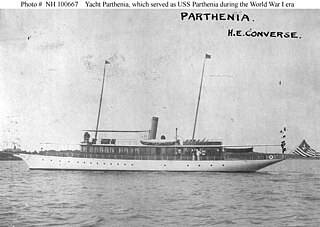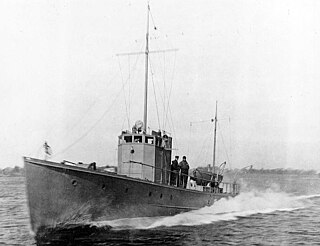
USS Cushing was a torpedo boat in the United States Navy during the Spanish–American War. She was named for William B. Cushing.

USS Sea Hawk (SP-2365) was an armed motorboat that served in the United States Navy as a patrol vessel from 1917 to 1919.

The first USS Du Pont was launched 30 March 1897 by Herreshoff Manufacturing Co., Bristol, R.I.; sponsored by Miss L. Converse; and commissioned 23 September 1897, Lieutenant Spencer S. Wood in command.

The first USS Gwin, was launched 15 November 1897 by the Herreshoff Manufacturing Co., Bristol, Rhode Island, and commissioned at Newport 4 April 1898, Lt, (j.g.) C. S. Williams in command.

USS Stiletto, a wooden torpedo boat, was launched in 1885 at the Herreshoff Manufacturing Co., Bristol, Rhode Island, as a private speculation. She was purchased for the United States Navy under an Act of Congress dated 3 March 1887, and entered service in July 1887, attached to the Naval Torpedo Station in Newport Rhode Island.

USS Inca (SP-1212) was a 62-foot-long motorboat leased by the U.S. Navy during World War I. She was outfitted as a patrol craft, but was additionally assigned other duties, such as rescue craft, seaplane tender, and dispatch boat. She served in the Boston, Massachusetts, and Hampton Roads, Virginia, waterways until war’s end when she was returned to her owner.
USS Inca (1911) was a ferryboat constructed for the U.S. Navy in 1911. She served the Navy at major American naval facilities located at Newport, Rhode Island; Norfolk, Virginia; and at Philadelphia, Pennsylvania. She conducted her ferrying services through World War I and then continued her work until the late 1930s, when she was finally struck by the Navy.

USS War Bug (SP-1795) was a three-armed motorboat in commission in the United States Navy as a patrol vessel from 1917 to 1918.

The second USS Commodore (SP-1425) was an armed motorboat that served in the United States Navy as a patrol vessel from 1917 to 1919. It was financed by Herbert M. Sears as part of the "Eastern Yacht Club 62 footers".

USS Apache (SP-729) was the first to be delivered of eight motor boats built by Herreshoff Manufacturing Company at Bristol, Rhode Island ordered and financed by members of the Eastern Yacht Club of Marblehead, Massachusetts. The boats were designed by Albert Loring Swasey and Nathanael Greene Herreshoff with the intention that the boats be used by the Navy as patrol craft and built with Navy approval of the design. Apache, as were the other boats, bore names under construction chosen by the owners and were then given the Section Patrol numbers on Navy acceptance and activation. The names were dropped after a period and all the boats then bore only the S.P. numbers.
USS Enaj (SP-578) was a United States Navy patrol vessel in commission from 1917 to 1918.

USS Parthenia (SP-671) was a United States Navy patrol vessel in commission from 1917 to 1919 or 1920.

USS Herreshoff No. 309 (SP-1218), also written Herreshoff #309, was a United States Navy patrol vessel in commission from 1917 to 1918.

USS Stinger (SP-1252) was a United States Navy patrol vessel in commission from 1917 to 1919.

USS Herreshoff No. 306 (SP-1841), also written Herreshoff #306, was a United States Navy patrol vessel in commission from 1918 to 1922.
USS Herreshoff No. 308 (SP-2232), also written Herreshoff #308, was a United States Navy patrol vessel in commission from 1918 to 1923.
USS Herreshoff No. 321 (SP-2235), also written Herreshoff #321, was a United States Navy patrol vessel in commission from 1918 to 1921.
USS Herreshoff No. 323 (SP-2840), also written Herreshoff #323, was a United States Navy patrol vessel in commission from 1918 to 1927.
USS Herreshoff No. 322 (SP-2373), also written Herreshoff #322, was a United States Navy patrol vessel in commission from 1918 to 1919.

USS Helianthus (SP-585) was a patrol vessel in commission in the United States Navy from 1917 to 1919, seeing service in World War I. After her U.S. Navy service, she was in commission in the United States Coast and Geodetic Survey as the survey launch USC&GS Helianthus from 1919 to 1939. She was named after the Helianthus, the genus to which the sunflower belongs.













